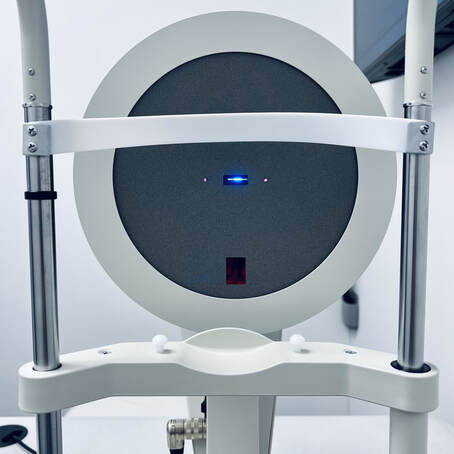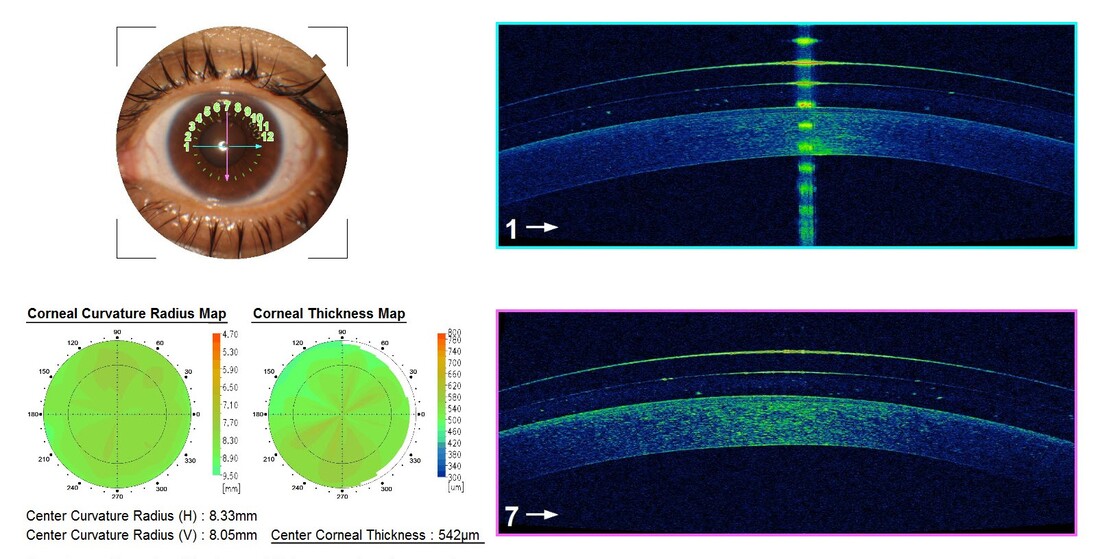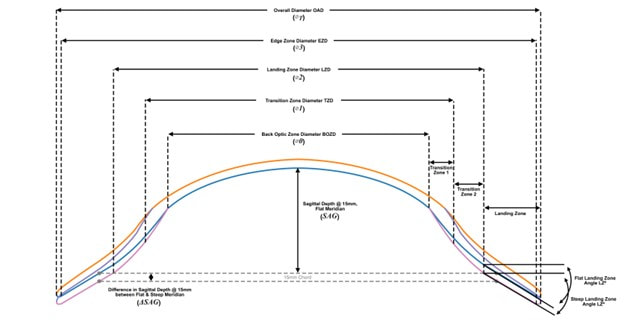What are scleral lenses?
A scleral lens is a special rigid contact lens that rests comfortably on the sclera (the white part of the eye surface) and vaults completely over the cornea (the central clear tissue). There is a liquid reservoir filling the space between the cornea and the lens which helps restore vision by essentially smoothing over irregularities and distortions on the cornea and providing a new optical surface for the eye to focus with. Scleral lenses typically have a lens diameter of 18mm or larger, while slightly smaller scleral lenses of 15-18mm in diameter are sometimes called mini-scleral lenses.
Who are scleral lenses for?
The majority of scleral lens patients have an irregular corneal condition, the most common being keratoconus. Other conditions where a scleral lens is beneficial include pellucid margin degeneration, corneal ectasia, neurotrophic keratitis, post-corneal graft, laser surgery complications, post-radial keratotomy (RK), severe corneal scarring from surgery, trauma or chemical injuries, and severe dry eye conditions such as Stevens-Johnson syndrome and Sjogren's syndrome where the tear reservoir behind the scleral lens acts as a protective lubricating layer for the cornea.
Scleral lenses can also be worn by patients with very high prescriptions, such as severe myopia or astigmatism, requiring a rigid lens but whose eyes are too sensitive for small-diameter corneal RGP lenses. As it covers the entire corneal surface, scleral lenses are occasionally worn as a protective device for the eye — Tom Cruise famously wore scleral lenses for some of his extreme stunt scenes while filming Mission: Impossible Rouge Nation.
How do scleral lenses compare with RGP lenses?
Scleral lenses are larger in size than corneal rigid-gas-permeable (RGP) lenses. The average adult cornea measures about 11.8mm across. Where RGP lenses are typically 9.0-9.5mm in diameter and rest directly on the cornea, scleral lenses do not touch the cornea and instead vault over it, resting just outside the cornea. As a result, scleral lenses do not move like RGP lenses with each blink, providing more stable vision and better wearing comfort.
RGP lenses can also cause mechanical rubbing on the cornea (especially the tip of the cone in patients with keratoconus) which in the long term may cause scarring. Scleral lenses avoid this issue. Patients who have moved from corneal RGP lenses to scleral lenses are often amazed by the difference in comfort and improvements in their vision. Scleral lenses can also treat higher amounts of corneal irregularity, including very advanced cases of keratoconus and hydrops that in the past would require corneal graft surgery, a complex procedure with high risks of complications. For many patients, wearing scleral lenses is a life-changing experience.
Are scleral lenses new?
The history of scleral lenses actually dates back to before the invention of corneal contact lenses. But in those days scleral lenses were made from blown glass and were not healthy for the eyes nor comfortable. Advancements in breathable rigid lens materials, manufacturing and fitting technologies in recent times have made scleral lenses much more popular for the treatment of irregular corneal conditions and severe dry eyes. And this is great news for patients who can benefit from wearing scleral lenses over regular corneal RGP lenses.
What to expect with scleral lenses?
As scleral lenses are much larger than a corneal RGP lenses and soft contact lenses, insertion and removal of scleral lenses can sometimes be a challenge at the start. Scleral lenses are inserted and removed with a different technique (see video below). There may be some frustrated mornings initially, but over a few weeks most patients adapt well to handling and wearing their scleral lenses. When the lenses are in, vision should be more stable and clearer than RGP lenses and certainly much clearer than with glasses. Occasionally you may need to remove your scleral lenses during the day to replenish the liquid reservoir with preservative-free saline, to maintain clear vision and prevent the lenses from fogging. Most scleral lens patients can comfortably wear their lenses from morning to night and enjoy good vision with them.
The scleral lens fitting process.
The fitting process of scleral lenses is more complex than regular corneal contact lenses. Following an initial assessment of your prescription and eye health, your optometrist will take a 3D topographical image of your eye surface with our corneal topographer to assess the areas of corneal irregularity, eye shape and size.
We then select an appropriate scleral lens from our trial lens set and assess how it fits on your eye.
With all this information we then use sophisticated computer software to design your individual set of fully customised scleral lenses.
Your scleral lenses will take around 2 weeks to manufacture. When your lenses are ready we will schedule a delivery consultation where we assess your lenses on your eyes and instruct you on how to use them and care for them.
Following this there will be several review consultations in the first few months to monitor your progress with your scleral lenses, to ensure your eyes remain healthy and your vision is satisfactory. Occasionally, your scleral lenses may need to be tweaked and modified to improve the fitting, vision or comfort — this is included in your package fee.
How much are scleral lenses?
INITIAL CONSULTATION & ASSESSMENT | $125
Your journey to wearing scleral lenses starts with a comprehensive vision and eye health examination with our expert optometrist. We take detailed scans of your cornea using our suite of advanced instruments including the Medmont Meridia corneal topographer and the Oculus Pentacam tomographer. These highly precise measurements are necessary to determine your suitability for scleral lenses and the lens parameters required to best fit scleral lenses to your eyes.
The Pentacam — a specialist instrument that measures the tissue shape of both the front and back surfaces of the cornea and its thickness profile — also allows us to track the progression of keratoconus and stage its severity. Patients who have documented progression of kerataconus may be suitable candidates for corneal collagen crosslinking (CXL) procedures to stabilise the condition.
SCLERAL LENS TRIAL LENS FITTING | $125
(This fee is waived for patients proceeding with a Scleral Lens Package - see below)
The best way to know how scleral lenses feel and how your vision might benefit from these lenses is to undergo a trial lens fitting process. This takes approximately 1 hour. Your optometrist will insert trial scleral lenses in your eyes based on your eye scan measurements. We will assess the fitting of the lenses on your eyes, using coloured dyes, imaging technology and anterior eye OCT 3D scans, and check your vision with the lenses in place. The trial lens fitting process helps determine the customised parameters for your unique set of scleral lenses.
SCLERAL LENS PACKAGE | FROM $2200
From your trial lens fitting session, your optometrist will advise you which design of scleral lenses is required for your specific case. The pricing depends on the complexity of your case, which is influenced by factors such as your prescription, astigmatism, eye shape, lens material, and if you have an irregular cornea or keratoconus how advanced your condition is.
The package fee includes the design and manufacture of one pair of fully customised scleral lenses, fitting consultation, instruction session, ongoing reviews and scans for the first 12 months, and a lens care kit to get you started. Lens parameter adjustments, if required, to refine the fitting of your lenses within the first 6 months are also included. If you have a valid Medicare card, you may receive a rebate from Medicare; the eligible rebate amount depends on your specific eye condition.
One set of scleral lenses can typically last 2 years if they are well looked after. Wear and tear from daily usage does occur and lens breakage can arise from any mishandling or placing excessive pressure on the lenses. We offer a lens warranty covering one accidental lens breakage per eye within the first 6 months; the broken lens must be presented for warranty claims.
Replacement scleral lenses are priced at $650-750 each, or $1300-1500 per pair, depending on the design, complexity and material.
Review fees are payable per visit outside of the initial 12 months included by your package.
If you have private health insurance with extras cover — such as Medibank Private, BUPA, or others — part of the cost of the initial package or replacement lenses may be claimable.
MEDIA
How to insert, remove and care for your scleral lenses:
See our contact lens practitioner to find out if scleral lenses are right for you.
Eyecare Concepts | The Myopia Clinic © 2017-23
KEW EAST | MELBOURNE
KEW EAST | MELBOURNE





